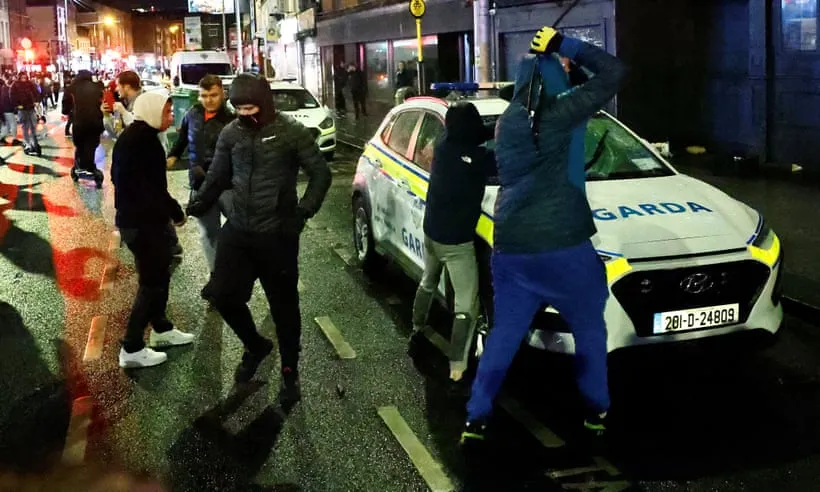Ireland’s police chief has warned that far-right radicalisation will continue to disrupt the country after a night of arson, rioting and looting left parts of Dublin resembling a war zone.
The capital was tense but calm on Friday as significant numbers of police remained on the streets and Dublin counted the cost of an anti-immigrant protest that turned into anarchy, leaving the political establishment shocked.
The cleanup began as fresh details emerged of the stabbing attack outside a school that left three children and a carer injured, two of them critically, and the suspect, reportedly a naturalised Irish citizen in his 50s, in custody and requiring medical treatment.
Claims that he was a foreigner spread online soon after the attack, which happened at about 1.30pm on Thursday, and drew a crowd to the scene at Parnell Square in the north inner city, leading to a riot in which 13 shops were looted, a tram and two buses torched, 11 police vehicles damaged, several officers injured – one seriously – and 34 people arrested.
Drew Harris, the Irish police commissioner, said people radicalised by far-right ideology and social media exploited a “terrible crime” to unleash mayhem. “What we saw last night was an extraordinary outbreak of violence. These are scenes that we have not seen in decades,” he told a press conference on Friday. “We have seen an element of radicalisation that is disruptive to our society.”
The scale of the unrest and level of hatred directed at officers would compel a fundamental review of public order tactics, said Harris. “We have to make the assumption that we’ll see further such protests.” More arrests would follow as police study CCTV footage, he said.
The justice minister, Helen McEntee, said some of those arrested would appear in court on Friday and if convicted of assaults on police could face stiff sentences. “We have very, very strong legislation – up to 10 years in prison with up to 12 years as well for someone who assaulted a member of An Garda Síochána,” she told RTÉ.
Resentment towards asylum seekers has in recent years fused with a housing crisis and concern about crime, leading to protests outside refugee centres, marches and a raucous protest in September outside the Oireachtas, Ireland’s legislature, that trapped lawmakers.
The stabbing incident happened outside a primary school, Gaelscoil Choláiste Mhuire, on Parnell Square, a busy thoroughfare that connects to O’Connell Street, Dublin’s main boulevard. A five-year-old girl and a female creche worker in her 30s were critically injured. A five-year-old boy and a six-year-old girl were treated for less severe injuries.
Bystanders disarmed the suspect, who reportedly had a large knife, and pinned him to the ground until police arrived. He is being treated in hospital and under guard. Police said the motive remained unclear but ruled out any terrorist link.
The creche worker, who has not been named, and a 43-year-old Brazilian Deliveroo driver, Caio Benicio, were hailed as heroes for intervening. “At first I thought it was a fight with a man and a woman. A normal fight like, you know, and I slowed down my motorcycle to see more closely what’s happening,” he told RTÉ. The woman was trying to pull a girl away, he said.
“She was very, very brave, you know, because you could get the girl from the man, and the little girl run away and the man he grabbed another one. So when I saw the knife, I just pull up, I just break my bike and pull up my motorcycle. I saw him stab the little girl.”
Benicio took off his helmet and used it as a weapon, he said. “Just hit him in the head with all power I have. And he fell down. And I hit him and then come other people and start to kick him.” Benicio lamented the ensuing riot. “There are protests against immigrants and I am immigrant and I was there, right there to protect Irish people.”
As speculation about the suspect’s nationality spread online, anti-immigrant activists flocked to the city centre. Bolstered by gangs of youths, they breached the police cordon around the crime scene and started roaming O’Connell Street, smashing windows, setting vehicles on fire and targeting some of the 400 police officers who tried to restore order.


